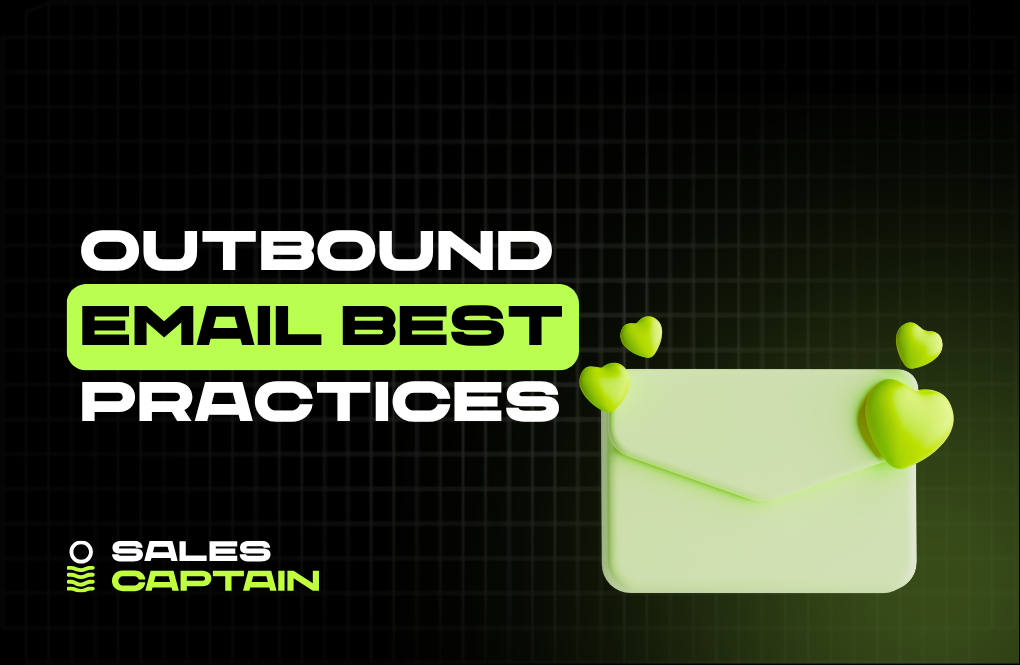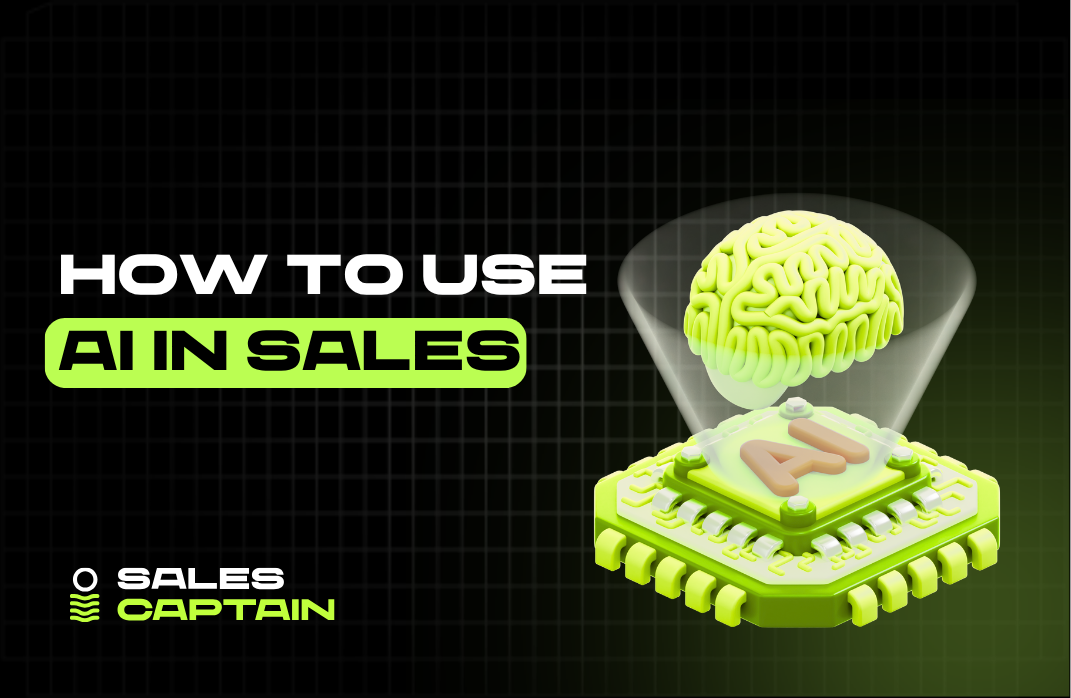

Automate LinkedIn Outreach: Scale B2B Prospecting Without Losing Personalization

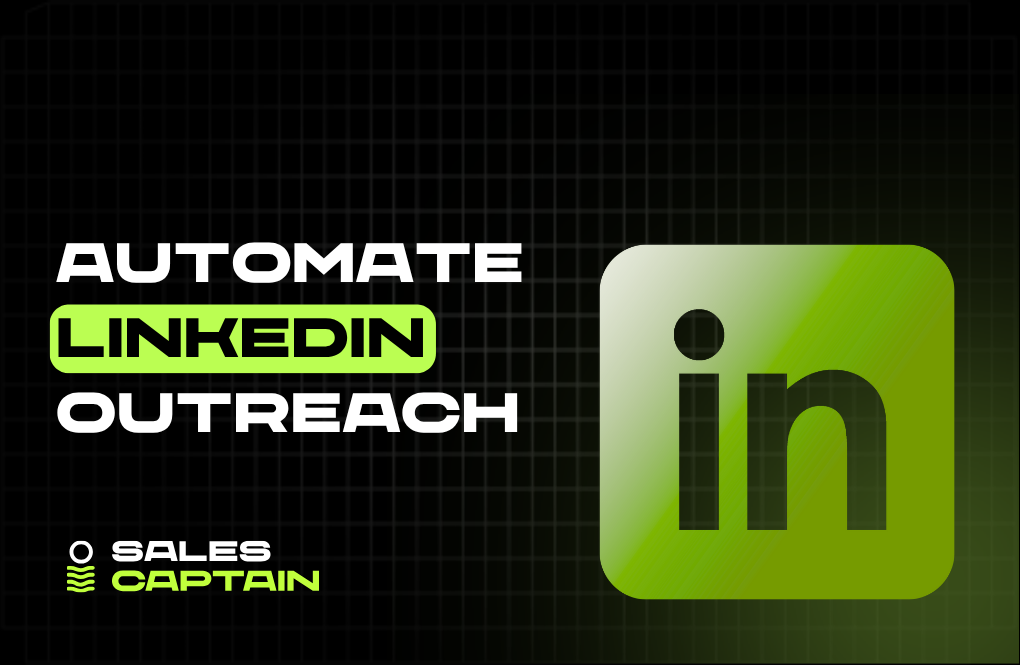
LinkedIn outreach still works. But doing it by hand? That kills your time and your focus. Automating LinkedIn outreach turns your outbound from a chaotic grind into a predictable system. You can scale conversations, test messaging, and surface qualified leads every day without losing the human touch. The goal isn’t to spam—it’s to build a smarter, faster GTM motion that moves with signals, not guesses. If you’re serious about outbound, automation isn’t optional. It’s the unlock.
Introduction to Automating LinkedIn Outreach
Why automate LinkedIn outreach?
Personalized cold outreach works. But doing it manually? Burnout city.
You can’t scale quality conversations if you're copying and pasting messages all day. Automation turns LinkedIn from a time-suck into a system, one that runs daily, finds prospects, sends messages, and surfaces warm replies.
It’s not about blasting spam. It's about building a repeatable outbound engine with signals, triggers, and iterations. Used right, automation doesn’t replace your brain, just the parts that slow you down.
Benefits of leveraging automation for lead generation
- Scale: Contact hundreds of prospects weekly without dying inside.
- Consistency: No more “I'll do outreach tomorrow” promises. Your pipeline fills, daily.
- Speed: Prospecting and follow-ups happen in minutes, not hours.
- Systemization: Outreach becomes part of your GTM infrastructure, not a one-off campaign.
- Testing: Run different versions of messaging and iterate fast.
The big unlock? Combining automation with signal-based targeting and personalization. That’s what makes outbound a growth motion, not just sales busywork.
When is automation the right choice?
If you're trying to:
- Generate qualified leads consistently
- Reduce dependency on SDR headcount
- Activate underutilized LinkedIn connections
- Test messaging and learn fast
...then it’s time. Especially if you’re scaling GTM or replacing legacy outbound with a modern stack.
But don’t automate just to do it. If your ICP isn’t clear, if you're still chasing product-market fit, if your offer’s weak, automation won't save you. It'll just make noise, faster.
Common misconceptions about LinkedIn automation
Most teams hold off because of these myths:
- “It’s spammy.” Only if you treat everyone the same. With the right data signals and personalization, outreach feels handcrafted.
- “You’ll get banned.” Not true, if you follow safety limits, rotate accounts, and avoid duplicate targeting, you're 100% fine.
- “It replaces human effort entirely.” Nope. Automation starts conversations. Humans close them.
- “Only sales teams should use it.” Actually, founders, growth marketers, even agencies use automation now. It's part of the modern GTM toolkit.
The truth: automation doesn't hurt your brand when it’s thoughtful, targeted, and value-driven. It just compresses time.
Key Use Cases for LinkedIn Outreach Automation
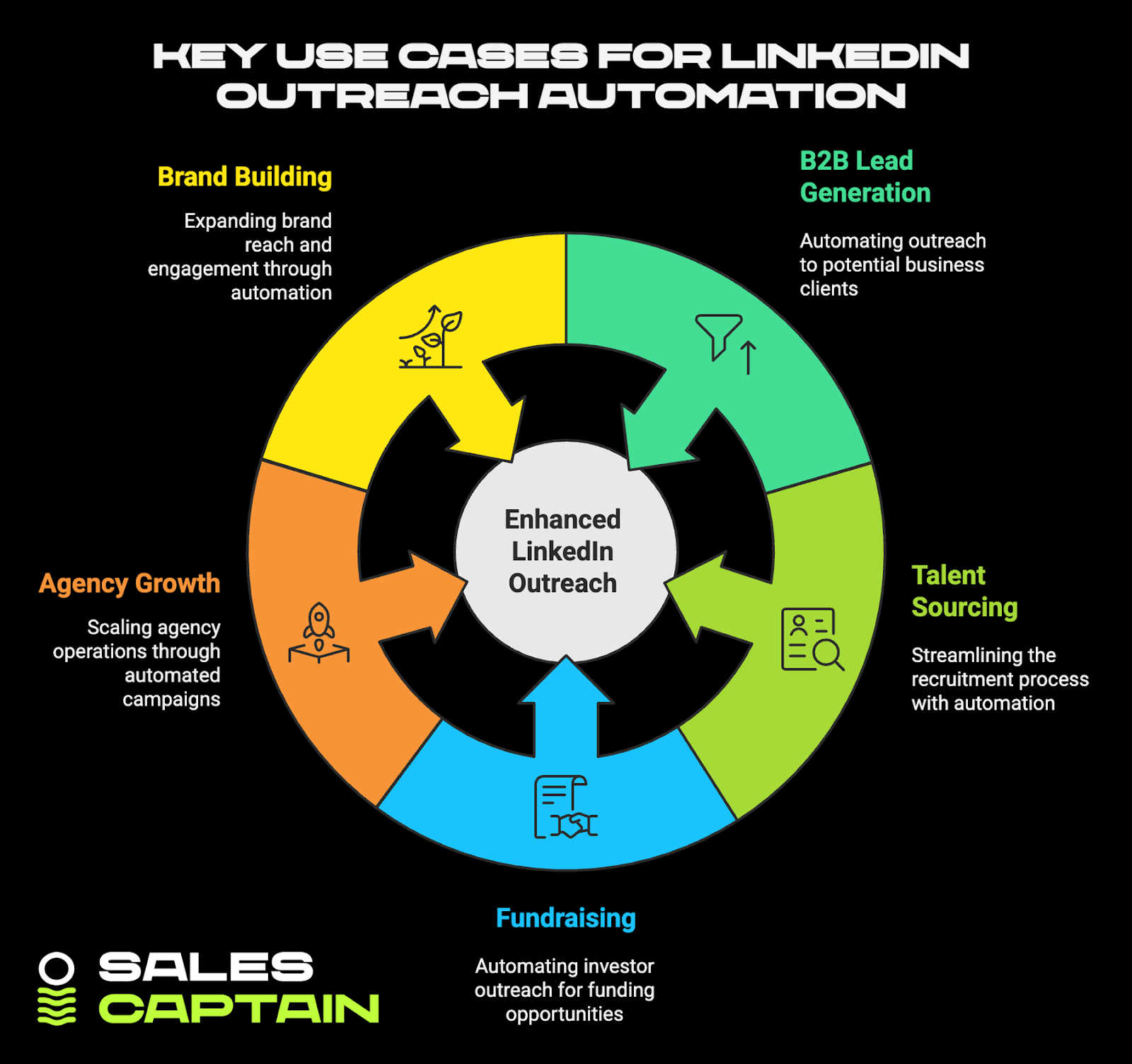
B2B lead generation
This is the obvious play, and still the most effective. If you're selling high-ticket SaaS, services, or consulting, outbound on LinkedIn gives you precision and immediacy.
Instead of waiting for inbound leads to trickle in, automation lets you go straight to decision-makers across industries, filter by job titles, company size, tech stack, and trigger events. Combine it with firmographic signals, and your pipeline builds itself.
Automation doesn’t just scale lead gen. It transforms it into a workflow: signal -> list -> message -> reply -> booked call.
Talent sourcing & recruitment
Recruiters waste hours searching, clicking, messaging. With automation, sourcing becomes repeatable.
You can filter for candidates by skillset, experience, job change activity, then send personalized messages at scale. Follow-ups run automatically. No ghosting. Just a structured process that keeps your top candidates warm.
Bonus: schedule sends during optimal windows when candidates actually respond. Make outreach feel human, not robotic.
Fundraising & investor outreach
Founders don’t have time to handwrite 100 investor intros. Outreach automation flips the game, especially when paired with the right signals.
Segment investors by stage, geography, portfolio fit. Personalize by previous investments or shared networks. Sequence messages over time to stay top of mind. Insert rapport, not spam.
Fundraising becomes predictable, not chaotic. And when a reply comes in, it’s warm and context-loaded.
Agency growth & client acquisition
Cold outreach is how growth agencies grow. But scaling it without burning your rep? That’s hard.
Automation lets agencies run tailored outbound campaigns by niche, pain point, or strategic angle. You can A/B test positioning, track metrics, and tee up sales calls on autopilot.
Done well, this is how demand gen agencies like SalesCaptain consistently drive pipeline for both themselves and their clients. Outbound becomes a GTM machine, not a hustle.
Brand-building and network expansion
Not every campaign needs to sell. Sometimes it's about expanding reach: connecting with influencers, engaging with peers, or starting thought-leadership convos.
Automated outreach can be used to connect with targeted audiences, invite them to webinars, share content, or start conversations that lead elsewhere, hires, partnerships, even product feedback loops.
Think of it like relationship infrastructure. Laid now. Monetized later.
How LinkedIn Outreach Automation Works
Prospecting and lead sourcing
Before any message gets sent, you need the right people to send it to.
Scraping and exporting prospect data
LinkedIn’s search UI is slow to navigate. Tools help scrape data points like names, titles, companies, and even recent activity. That data can be cleaned and exported into CSVs or your automation platform.
Scrapers shouldn’t just pull profiles. They should enrich with attribution signals, job changes, funding rounds, hiring sprees. That’s where Clay shines: it lets you build hyper-specific lists using workflows that combine LinkedIn, third-party APIs, and real-time signals.
Using LinkedIn Sales Navigator & filters
Sales Navigator is still the gold standard for laser-targeted searches. Filter by seniority, function, geography, company size, industry.
Smart operators export Sales Nav searches into their automation stack, turning manual filters into prospecting engines. Layer in intent or activity signals to go beyond just job titles.
The goal? Don’t just send more messages. Send smarter ones.
Message personalization techniques
The difference between “delete” and “reply” is how your message sounds. Even in automation, you can make it personal.
Dynamic fields and spintax
These placeholders let you vary messages for each prospect: {first_name}, {company}, {job_title}, but also more advanced variables like shared interests or mutual connections.
Spintax adds copy variation to prevent repetitive patterns. Think: “Curious if this is on your radar” vs “Wondering if you’re open to this idea.”
Done well, it reads like you typed it yourself. Except you didn’t.
Video and image personalization
Want replies? Add personalized media. Tools can merge dynamic text into images or overlay names into explainer videos.
Send a GIF of your product with their company’s logo. Or a 20-second video saying, “Hey John, noticed you run RevOps at {company}…”
It stops the scroll. And earns attention. Even when automated.
Sequencing and drip campaigns
Outreach is rarely one-and-done. Sequences build momentum.
Defining workflows: connection, follow-ups, replies
A basic flow might look like:
- Day 1: Send connection request
- Day 3: If accepted, send initial message
- Day 6: Soft follow-up
- Day 10: Nudge with a value-add or asset
- If replied: auto-pause the sequence
You define the rhythm. The system executes it.
Multi-step sequences and conditional logic
Smart tools let you build logic: “If they don’t connect, try InMail,” or “If they visited our site, change path.”
You can split flows by industry, job function, or even message behavior. Outreach isn’t linear anymore. It adapts in real time, like a conversation should.
Inbox and reply management
Messages are easy. Managing replies is where deals are made.
Smart inboxes and centralized communication
No one wants to juggle 6 LinkedIn accounts and 12 conversations. Smart inboxes consolidate replies, letting you handle everything from one dashboard.
Some tools route replies to specific reps. Others detect intent and tag messages based on interest levels. Either way, inbox chaos becomes structured.
Smart reply categorization and sentiment tracking
Not all replies are created equal. Some say “I’m interested.” Others ask for more info. A few just say “No.”
Reply sensing sorts responses into buckets, interested, neutral, not now. Some even detect tone to surface warm leads faster.
Fewer missed replies. Faster handoffs to sales. More closed deals.
Multi-Channel Outreach Beyond LinkedIn
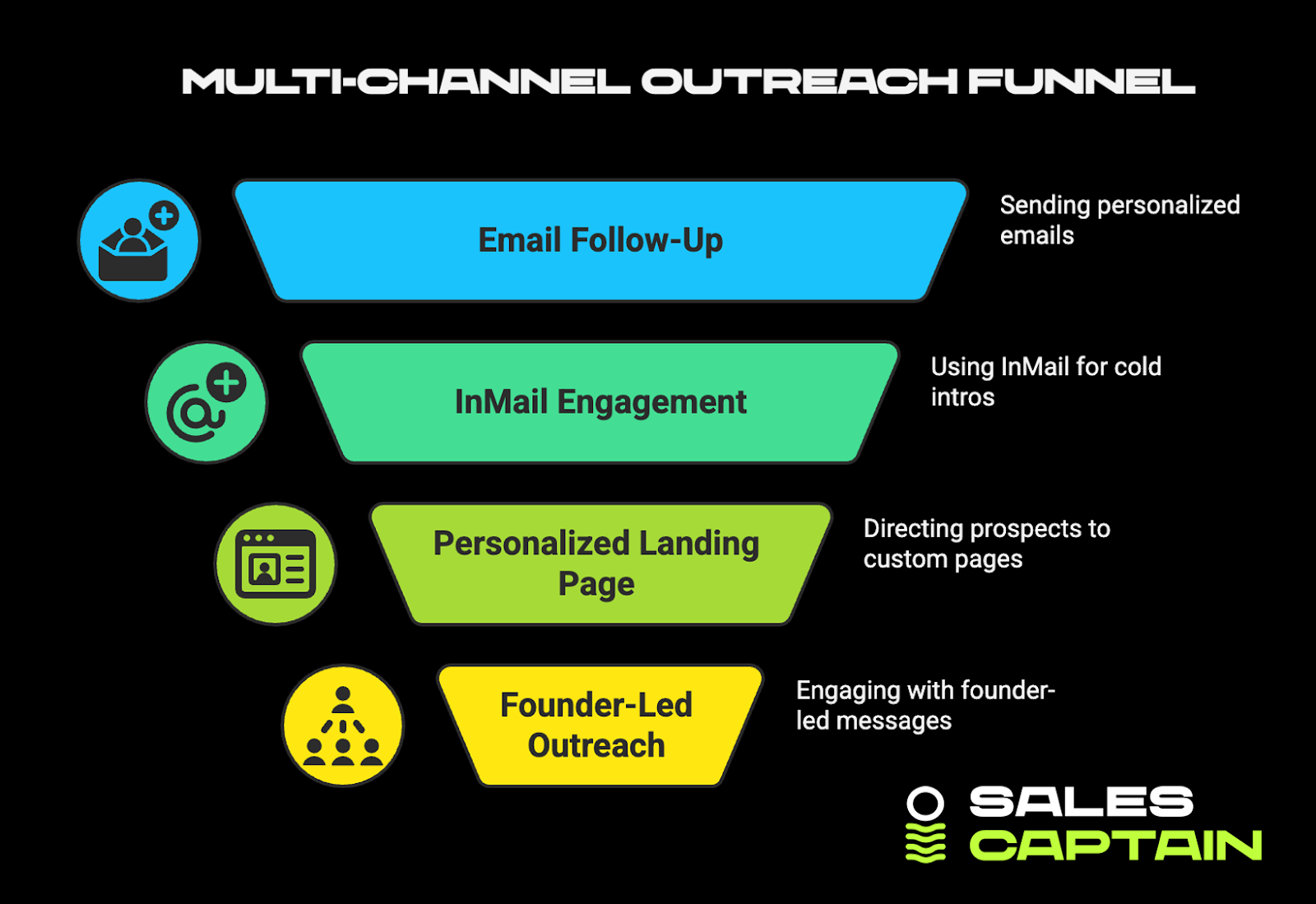
Combining LinkedIn with email
LinkedIn alone can get noisy. But paired with email? That’s where magic happens.
Multi-channel sequencing lets you connect on LinkedIn, then follow up with a personalized email, or vice versa. You stay top of mind without sounding like a bot.
Engage across both platforms. Context stack your messages. Multiply reply rates.
Leveraging InMail and cold messaging strategies
InMail still works, if you use it for the right personas. Think recruiters, enterprise leaders, or those who don’t accept connection requests easily.
Use InMail for cold intros. Retarget non-responders who didn’t accept your invite. Add value fast. Get to the point. Then pivot to conversation.
Think of InMails like ads. You only have seconds to win attention. Use them wisely.
Personalized landing pages and funnel integration
Where do your LinkedIn prospects land after they reply?
Smart operators route them to personalized pages: custom demos, “built for you” landing pages, or pre-filled forms. It builds trust, shortens sales cycles, and moves them deeper into the funnel.
Blend outreach with funnel architecture. Every reply is a conversion event.
Founder-led and signal-based outreach
Founder-led outbound still converts best. Add signal-based timing, and you’re unstoppable.
Look for moments like:
- Job changes
- Fundraises
- Hiring trends
- Press mentions
Trigger outreach that speaks to those signals. It feels relevant. Timely. Human. And when it comes from a founder? Response rates go up.
That’s not just outbound. That’s narrative-led growth.## Selecting the Right Automation Tool
Key evaluation criteria (features, use case fit, budget)
Not all outreach tools are built the same, or for the same buyer. Choosing the right one depends on your motion.
Here’s how to break it down:
- Features, Look for safety controls, sequencing logic, account rotation, personalization, inbox management, analytics. If you're not running multi-step campaigns with variations, you're not scaling.
- Use case fit, Are you prospecting for SaaS leads? Hiring? Pitching investors? Some tools are pure sales; others lean into marketing or brand outreach. Match tool strengths to your motion.
- Budget, Some tools start at $30/month. Others scale into thousands for team plans, multi-account orchestration, and integrations. Don't just look at price, count ROI per booked meeting.
Technical GTM teams treat tools as infrastructure, not shiny objects. No one’s shopping features, they’re building systems.
Strategic Tips for Successful LinkedIn Outreach Automation
Warming up LinkedIn accounts
Before you crank volume, build trust.
New or inactive accounts can’t jump to 100 connection requests a day. That’s the fastest path to getting throttled or flagged.
Start slow:
- Week 1: View profiles, engage with posts, send 10–20 requests daily
- Week 2: Gradually ramp to 40–60 requests
- Week 3+: Stabilize at safe daily limits (~80/day max)
Let your account behave like a human, not a bot. Rotate message templates, vary times, stay under radar.
This matters 10x more with aged or burner accounts you’ve bought or inherited.
Writing high-converting outreach messages
Automation sends the message. Writing gets the reply.
Forget stale templates or LinkedIn bro-talk. Smart outbound is concise, relevant, and signal-aware.
Some real rules that work:
- Lead with relevance, a shared connection, recent activity, or company news
- Ditch the pitch, your first message isn’t a cold call. It’s a handshake.
- Personalize the hook, show you’ve done homework
- Keep it short, 2–4 lines max. Long walls never get read.
- Use casual tone, we’re on LinkedIn, not email
Good message:
“Hey Sarah, saw you’re hiring 3 SDRs, thinking RevOps might be a bottleneck soon. Quick idea we’re using with 2 others in fintech, might be useful?”
Bad message:
“Hi Sarah, I came across your profile and I wanted to introduce myself as the co-founder of a cutting-edge RevOps consultancy increasing client ROI by 53%…”
You feel the difference.
Timing and frequency strategies
Timing = reply rate fuel.
Some basic cadence tactics:
- Best windows: Tues–Thurs, 9–11am or 2–4pm (recipient’s time zone)
- Follow-ups: 3–4 days apart, max 3–4 follow-ups total
- Avoid weekends, Mondays, and after 6pm sends
- Use business hours, randomized spacing for authenticity
Frequency adds compound lift. Sequences stretch attention spans, not every prospect replies at message 1. Some respond at follow-up 3 if the offer hits right.
Just don’t turn your sequence into a reminder spam series. Each message should add value or angle, not just “bumping this up.”
Using real-time triggers and buying signals
Timing + relevance = conversions. Real B2B operators build outreach triggers, not just lists.
Signals that move pipelines:
- Job change → new decision authority, fresh tech budget
- Fundraise → hiring or growth push
- Hiring role → potential need for your product or service
- Tech stack change → displacement opportunity
- Content published → top-of-mind topic, strike when warm
Use tools or workflows (like Clay or Clearbit Reveal) to surface these. Then trigger LinkedIn touchpoints within hours.
If you're automating outreach purely on static firmographics, you're a step behind.
Continuously optimizing campaigns through data
Every reply, or non-reply, is a signal.
Optimizing automation means building a loop:
- Track reply rates, connection accepts, positive interest quals
- Kill low-performers, double down on high-converting variants
- Test new CTAs, openers, angles every two weeks
- Segment messaging by persona or intent signal
Outbound is now closer to paid media, launch, test, learn, iterate.
This is where agencies like SalesCaptain make moves. They don’t just “send messages.” They analyze reply behaviors, pick winners, and systemize conversion paths.
If you’re not treating outreach like a growth funnel, you’re mailing letters into the void.
Common Challenges with Automation (and How to Solve Them)
Low reply or conversion rates
If you're sending messages and hearing crickets, here’s the likely culprit lineup:
- Weak targeting, wrong persona or intent timing
- Generic messaging, nothing relevant or differentiated
- Poor offer, no clear value or reason to care
Fix it:
- Rebuild your lead criteria with tighter signals
- Test 2–3 message angles, voice tones, and formats
- Record and track conversion metrics by step (connection rate, message 1 reply, total interest)
Sometimes, it's not the tool. It's the message-market match.
Flagged or restricted accounts
Nothing kills velocity like account flags. And they happen fast if you:
- Ramp volume too quickly
- Copy-paste messages fast manually (yes, LinkedIn sees that)
- Use spammy templates or link-dumps
Avoid it:
- Throttle ramping, especially on new accounts
- Vary templates and use delay timers on automated sends
- Never include links in the first message unless highly relevant
Tools with native safety logic (random delays, daytime controls, template rotation) are a must. Don’t wing it.
Lead quality discrepancies
Good volume. Poor meetings. Happens all the time.
Why?
- Sourcing from the wrong list
- Relying only on LinkedIn filters
- No signal-layered criteria
Solution:
- Stop kidnapping leads from “job title only” targeting
- Enrich with buying signals (job change, hiring, tools used)
- Use systems that allow logic-based lead sourcing, not static exports
If you're not layering data, you're generating interest from the wrong people.
Message fatigue or personalization fails
Prospects can smell automation. Especially if:
- Everyone gets the same 2-line “quick intro”
- You reference their company name, but nothing meaningful
- Messages lack human tone or conversational flow
Combat this:
- Rotate message structures
- Use real personalization, actual context, not just variables
- Add pattern interrupts (custom images, mutual mentions, quick Loom vids)
Automation works when it doesn’t feel automated. That balance is where results live.
Automation Best Practices & Ethical Considerations
Staying compliant with LinkedIn policies
LinkedIn tolerates automation, not abuse.
To stay safe:
- Keep daily send limits under 100 (or less for newer accounts)
- Don’t use browser-based bots or scripts that mimic interaction too aggressively
- Rotate templates and account behavior to mimic real use
Cloud-based tools with native throttling and behavior control help insulate risk. Read the Terms. But more importantly: don’t act like a spam farm.
Not spamming vs. value-driven outreach
Spam = identical messages to thousands of people, with zero context.
Value = tailored outreach to relevant people, with real information or an opportunity to explore.
Here’s the gut check:
- Would YOU reply to this message if you got it cold?
- Is there a genuine insight, question, or thought that shows it’s not mass?
- Could you explain why this person was chosen, to them?
If the answer is no, rewrite it. Or don’t send it.
Ethical scraping and data usage
Scraping is a tool. Misusing it is a choice.
Don’t:
- Pull people’s emails from private databases and blast them
- Automate follow-ups endlessly until they respond
- Use scraped data without relevance
Do:
- Scrape publicly visible data for targeted outreach
- Enrich with first-party context or shared signals
- Respect opt-outs or negative replies
Ethical outbound doesn’t mean toothless campaigns, it means relevance-driven, signal-based systems.
Creating an authentic brand voice at scale
Automation doesn’t mean bland. But it’s easy to lose tone when you scale.
Tips to stay human:
- Use your real voice, casual, clear, not corporate
- Add founder-level language (“We’re testing this with 3 others…”) to create rapport
- Rotate messaging to speak in different rhythms and vibes
Brand isn’t visuals. It’s how your words land. Even in direct messages.
Setting Up Your First Campaign: Step-by-Step
Choose a tool and plan setup
Pick the tool that fits your motion. B2B SaaS team? Go with something sequence-heavy like Expandi or Clay. Scraping layer needed? You’ll want Clay in your stack.
Set up the account, configure safety settings, and connect LinkedIn profiles. Define who’s managing inboxes. Then map your execution plan.
Define your audience and build your lead list
Great outreach starts with better lists. Go narrow.
Layer filters like:
- Job title + seniority + niche industry
- Company size + hiring activity
- Tech stack + intent signals
Use tools like Clay for signal-based scraping and enrichment, it turns raw LinkedIn filters into actionable, real-time lead flows.
Export as CSV, or push directly into your chosen automation layer.
Draft personalized sequence messages
Write tight, 2–4 message sequences that:
- Hook with context
- Add relevance or insight
- Invite a low-friction next step
Use dynamic variables, spin message variation, and map different paths based on persona type or stage.
Avoid hard asks upfront. Start conversations, not sales pitches.
Launch the campaign and monitor performance
Start small, 50–100 leads to validate messaging and flow.
Track:
- Connection acceptance rate
- Message 1 reply rate
- Overall interest or demo booked rate
Listen to replies. Are they curious? Confused? Ghosting? The inbox is your feedback lab.
Adjust based on insights and scale success
Once you’ve found a sequence or persona that pops, double down.
Clone high-performing flows. Tweak by segment. Layer more signals. Rerun successful campaigns into similar lists.
Automation isn’t “set and forget.” It’s set, learn, tweak, repeat.
Think like a GTM operator, not just an outreach sender. That’s how campaigns become systems.## Future of LinkedIn Outreach Automation
Role of AI in personalization and workflow automation
AI isn't just speeding things up. It's changing how personalization works, at scale.
Instead of rule-based templates, AI tools can now craft contextual messages based on dynamic factors, job changes, recent posts, and company milestones. It's not just using {first_name}, it's referencing the CFO’s quote from last week’s press release in your message.
But it’s also automating operational workflows. That means:
- Auto-scraping and enriching leads
- Assigning sequences based on persona fits
- Adjusting follow-ups based on reply sentiment
- Stopping campaigns when a positive response hits
Outreach isn’t just a “campaign” anymore. It’s an intelligent workflow. Messages go out, data flows in, and the system refines on its own.
Think fewer SDRs. More technical operators with AI-fluent GTM stacks.
Integrating sales signals and intent data
Timing kills or converts. Signals make timing predictable.
Modern GTM teams aren’t just targeting by title. They’re layering:
- Job changes
- Recent funding rounds
- New tech installs
- Hiring sprees
- Shared content activity
Good outreach automation platforms connect these signals (via APIs or tools like Clay) to trigger message sends the moment interest exists. No lag. No guesswork.
This turns outbound into a full-funnel marketing motion, surfacing leads who are both the right person and ready now.
Predictive analytics and lead scoring
The next shift? Outreach platforms that don’t just react to leads, they prioritize them based on conversion probability.
Predictive lead scoring frameworks analyze:
- Engagement history (opens, replies, profile views)
- ICP match strength
- Account-level signals
- Response sentiment over campaigns
This data gets crunched into scores, so you know where to spend time, and where sequences need adjustments.
Now, instead of just running outreach, operators build systems that optimize reply probability and booking potential in real-time.
Outbound officially joins the predictive revenue game.
The increasing importance of human-like interactions
AI might automate the action. But it can’t replace trust. Human-like tone, authentic conversations, these still win.
So automation’s next evolution isn’t just about better targeting, it’s about being indistinguishable from real human outreach.
That means:
- Varied send times and tones
- Conversational copy over pitchy scripts
- Media that feels custom, not mass-generated
- Responses that route to real reps, fast
Buyers know bots exist. They just don’t want to talk to one. The best outbound campaigns feel like a smart human is behind them, even if the process is full-stack automated.
That’s the frontier: scale with soul.
FAQs
Yes, if you're smart about it.
Safe outreach means:
- Using cloud-based tools (not browser bots)
- Throttling send volumes to human-like levels
- Varying message templates to avoid patterns
- Rotating actions within standard activity hours
Most bans happen from aggressive behavior or overriding safety controls. With thoughtful setup and modern tools, automation is frictionless and safe.
Not if you use tools designed to mimic real behavior.
LinkedIn flags patterns, not automation itself. So if you’re sending 200 messages a day from a new account with identical text, you’re getting flagged.
But if you're:
- Staying within safe daily limits
- Randomizing interactions
- Using tools that silo browser activity
...you're good.
Bonus: platforms like Expandi and HeyReach build these guardrails in by default. Just don’t break them trying to go faster.
It depends on your motion.
- For signal-based prospecting and integrated outbound workflows, Clay is the most flexible and powerful stack starter.
- For outreach delivery at scale with strong safety controls, tools like Expandi or HeyReach dominate.
- Running multi-channel outreach (LinkedIn + email)? Meet Alfred or Snov.io work well.
There’s no one-size-fits-all. Define your use case, evaluate your tech fluency, then match the tool to the system you’re building.
No, but it helps.
Sales Navigator gives you access to advanced filters: headcount, geography, seniority, activity. That lets you build hyper-targeted lists before pushing them into automation.
Without it, you're stuck with basic LinkedIn search, which is slower and less precise.
If you're serious about outbound, especially in B2B, Sales Nav pays for itself in weeks with better list quality and results.
Yes, if the tool supports it.
Platforms like HeyReach and Expandi are built for multi-account management. Perfect for agencies, growth teams, or solopreneurs running multiple personas.
You get:
- One view across campaigns and messages
- Individual inbox routing by account
- Centralized safety settings
Just make sure your tool uses separate IPs or browser environments for each account. Otherwise, LinkedIn will catch the bot footprints.
You layer context into variables.
Basic personalization = using {first_name}, {company}, {job_title}. But that’s table stakes.
Next-level personalization pulls in:
- Recent funding events
- Interview quotes
- Shared connections
- Job openings
Tools like Clay let you auto-enrich data before outreach. So your automation isn’t just personal, it’s relevant, with hooks that feel handcrafted.
That’s how you get replies like, “Wait... is this automated?” (in a good way).
Safe zones:
- New account: 10–30 daily (ramp slowly)
- Aged/warmed account: 40–80 daily
- Established, active account: up to 100 daily (with rotation and template variation)
Always space connection requests throughout the day. Don’t blast them all at once. And alternate with natural actions, like profile views or post comments.
Scale slow. Stay under radar.
RELATED ARTICLES
Lorem ipsum dolor sit amet, consectetuer adipiscing elit, sed diam nonummy nibh euismod tincidunt ut laoreet dolore magna aliquam erat volutpat.
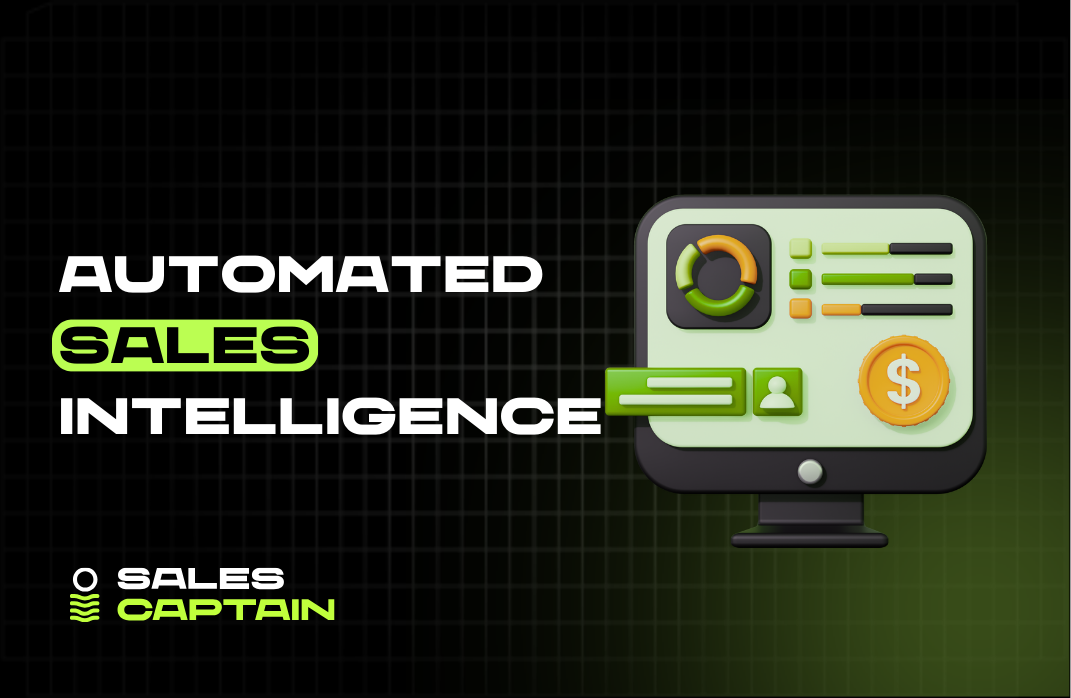
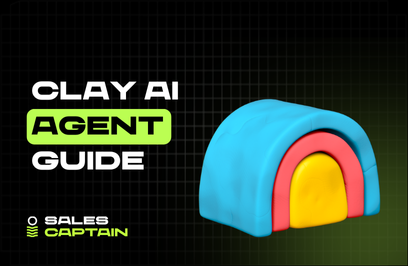
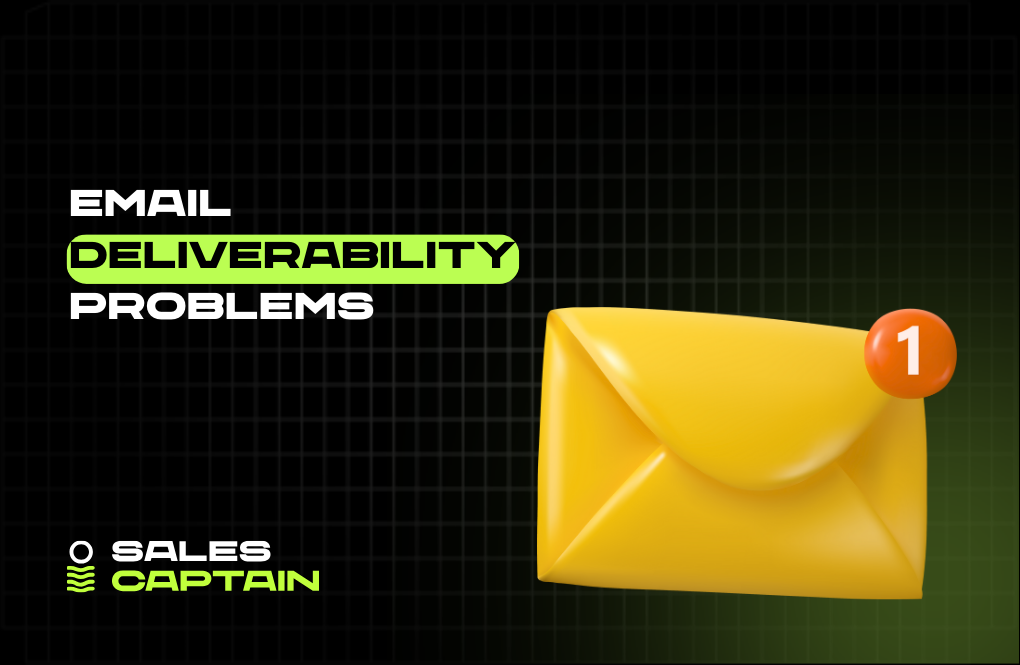

.jpg)
